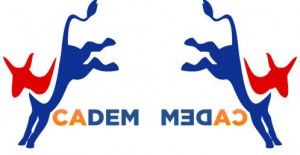Dems spend wildly in CA jungle primaries
by James Poulos | February 19, 2015 5:00 am
 In California, Democrats have shelled out big bucks to beat fellow Democrats, despite research suggesting their voters see them fairly interchangeably.
In California, Democrats have shelled out big bucks to beat fellow Democrats, despite research suggesting their voters see them fairly interchangeably.
In a new report issued by Forward Observer,[1] Golden State Democrats were found to drop over $100 million since the 2010 passage of Proposition 14[2], the initiative that set up the Top Two primary system. The measure created a so-called “jungle” primary system, where the top two candidates square off in the general election, regardless of whether they’re both members of the same party.
In the report, Democrat-on-Democrat spending dwarfed what Republicans shelled out when running against other Republicans. “For every dollar spent or raised by Republicans in these intra-party contests,” Forward Observer concluded, “$3.26 was raised or spent by Democrats.”
The finding struck a significant contrast with provisional conclusions by political analysts that low-information voters didn’t discriminate much among candidates from the same party.
Kevin Drum used that judgment to argue[3] in Mother Jones that “jungle” primaries didn’t much impact California politics:
“In 2012, for example, researchers polled voters using both a traditional ballot and a top-two ballot. There was no difference in the results. One reason is that most voters knew virtually nothing about any of the candidates. Were they moderate? Liberal? Wild-eyed lefties? Meh. Voters weren’t paying enough attention to know.”
In a report drawing similar conclusions from a host of recent studies, the Los Angeles Times determined[4] Californians weren’t any more likely to vote for relatively less ideologically extreme candidates, one of the rationales advanced by “jungle” primary advocates.
Voters “were just as apt to support candidates representing the same partisan poles as they were before the election rules changed — that is, if they even bothered voting,” according to the Times.
“To summarize, our articles find very limited support for the moderating effects associated with the top-two primary,” said Washington University’s Betsy Sinclair, as quoted in the Times, which noted her research summarized six research papers.
A surge of outside money
Further complicating the political narrative for state Democrats, Forward Observer found their outsized intra-party campaign spending came in substantial part from Independent Expenditure committees, or IEs.
Another factor is the U.S. Supreme Court’s 2010 decision, Citizens United vs. Federal Election Commission[5], which took a permissive approach to outside political spending. Since then, liberals and progressives have worried IEs would throw the balance of electoral power to wealthy private interests and, ostensibly, the Republican Party.
As Silicon Valley critic Andrew Gumbel put it[6], money-in-politics activists worry most about “the under-the-radar stuff that happens away from the media spotlight, often in smaller jurisdictions or in other states. The advent of super-PACs and unlimited independent expenditures makes it possible for billionaires to play a much longer game and to reap far greater successes as long as they are patient.”
In California, the data have provided a different story, with IEs fueling intra-party competition among Democrats most of all. “IEs raised or spent $30.9 million in Democrat-vs-Democrat campaigns and $10.1 million in Republican-vs-Republican campaigns,” Forward Observer calculated.
Notably, the findings underscored earlier research on the impact of IEs in California’s “jungle” primaries. As CalWatchdog.com previously reported[7]:
“Out of 52 same-party races across elections for California’s state Senate, Assembly and House of Representatives, Democrats faced Democrats in 36 contests, while Republicans went head to head in 16 match-ups. Democrats poured $69 million into those three dozen races, while Republican totals reached just over $20 million, according to information drawn from the offices of the state Fair Political Practices Commission and the Secretary of State’s Office, as well as the Federal Election Commission.”
A consistent pattern
Lest analysts think that IEs have distorted other prevailing trends in campaign spending, Forward Observer’s calculations also revealed that money raised or spent by campaign committees themselves also fit the pattern followed by IEs.
Campaign committees, Forward Observer noted, were responsible for “$72.4 million in Democrat-vs-Democrat campaigns and $21.6 million in Republican-vs-Republican campaigns. This was true across both election cycles and across all three chambers – the California Assembly, Senate, and the U.S. House of Representatives.”
Since its passage in 2010, the Top Two system still has run through only two election cycles. But so far, it has fulfilled proponents’ prediction that formerly one-party races, in which the November election was a mere formality, would be replaced by tough competition between two candidates from the same party.
- new report issued by Forward Observer,: http://www.fwdobserver.com/news/
- Proposition 14: http://ballotpedia.org/California_Proposition_14,_Top_Two_Primaries_Act_%28June_2010%29
- argue: http://www.motherjones.com/kevin-drum/2015/02/jungle-primaries-california-it-looks-big-fat-meh
- determined: http://www.latimes.com/local/politics/la-me-pol-california-politics-20150208-story.html
- Citizens United vs. Federal Election Commission: http://www.scotusblog.com/case-files/cases/citizens-united-v-federal-election-commission/
- put it: http://capitalandmain.com/inequality/silicon-valleys-brave-new-economic-order
- reported: http://calwatchdog.com/2014/09/17/dems-spending-more-campaign-cash-against-dems-in-open-primary-system/
Source URL: https://calwatchdog.com/2015/02/19/spending-runs-wild-for-dems-in-ca-jungle-primaries/